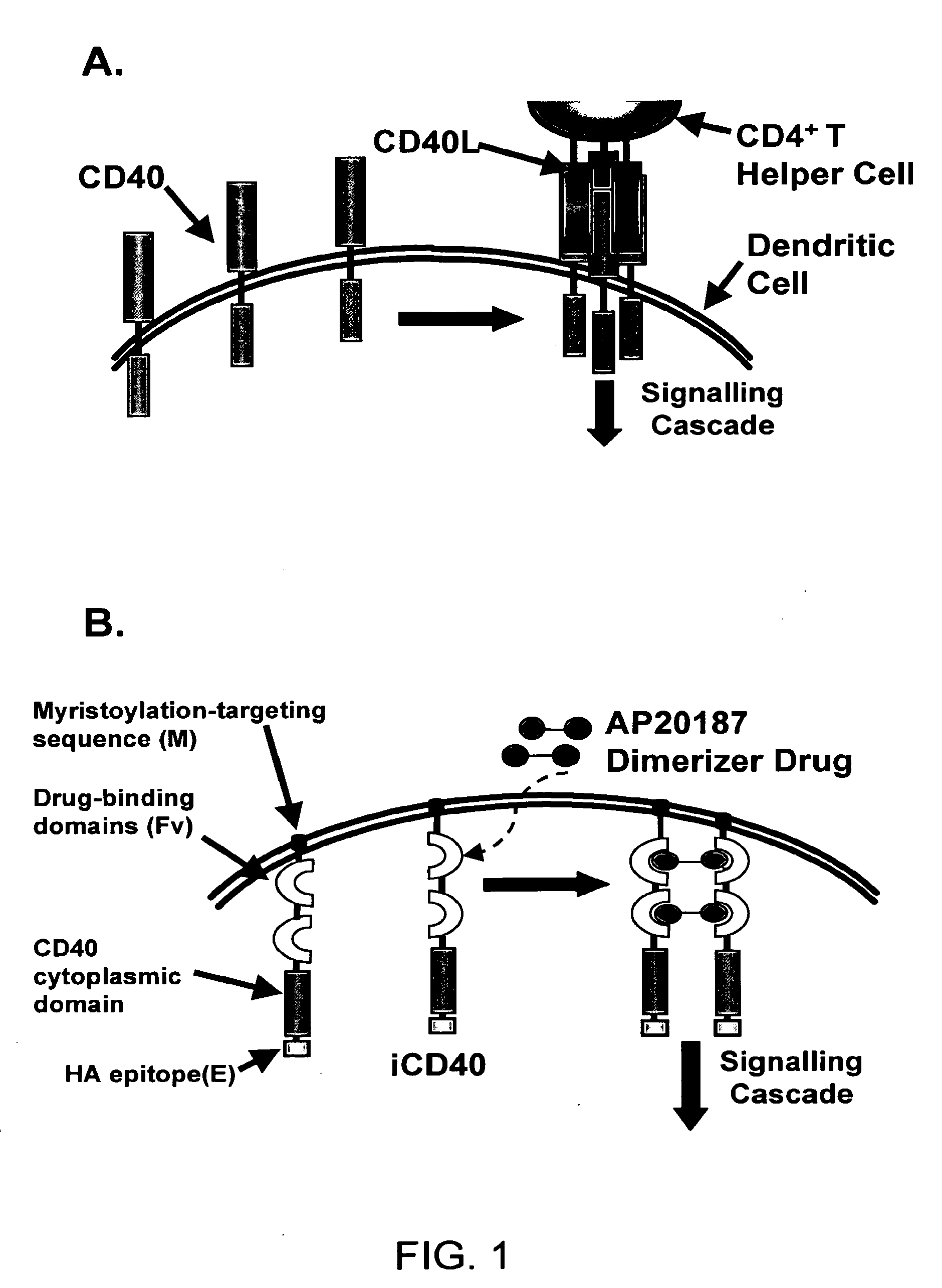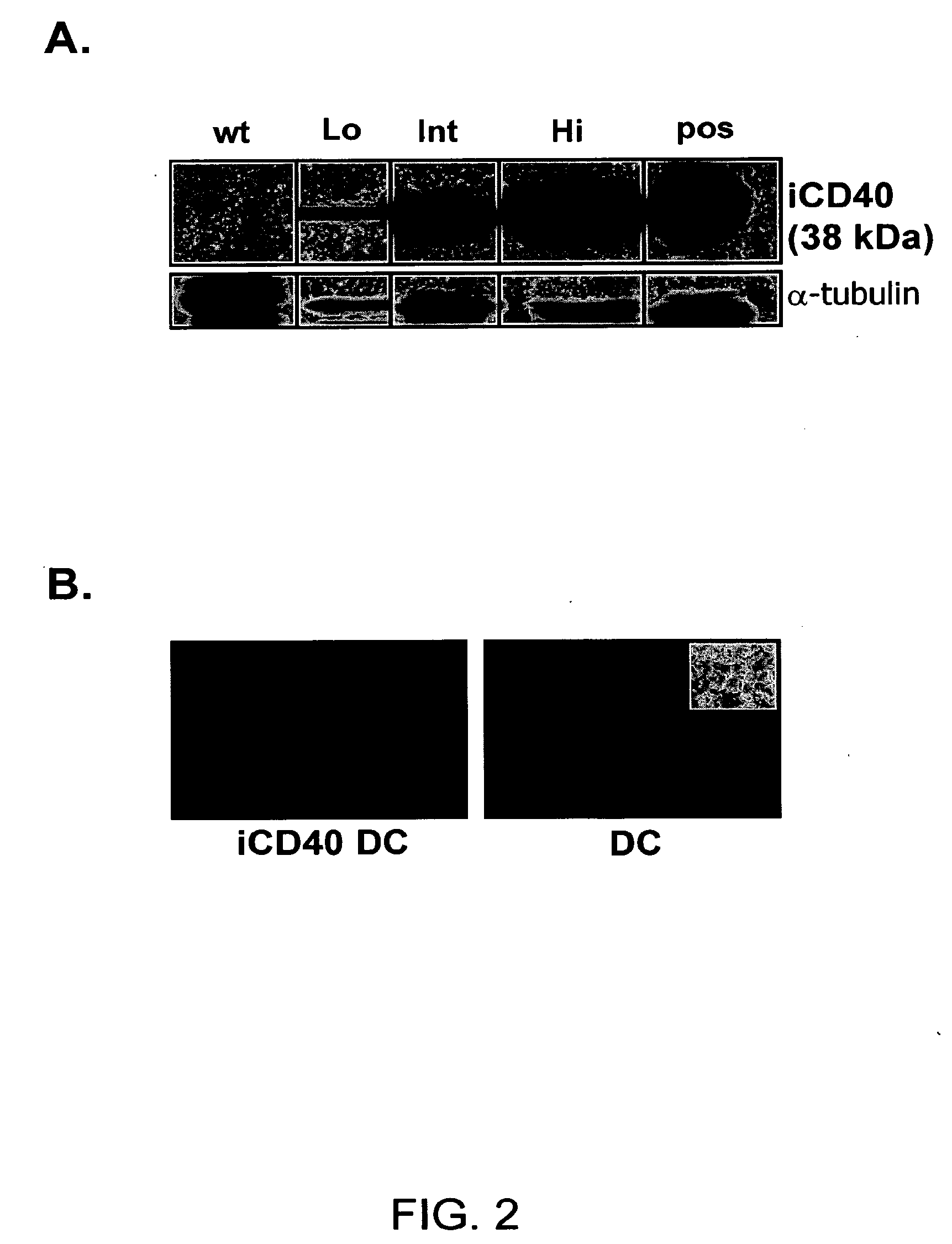Induced activation in dendritic cells
a dendritic cell and activation technology, applied in the field of dendritic cell activation, can solve the problems of cytotoxic t lymphocyte (ctl) activation potential of dcs, inability to fully activate dcs, so as to achieve the effect of enhancing and/or regulating immune responses to a target antigen
- Summary
- Abstract
- Description
- Claims
- Application Information
AI Technical Summary
Problems solved by technology
Method used
Image
Examples
example 1
Development of Techniques for Efficient Isolation of DCs
[0244]Bone marrow from the tibias and femurs of C57BL / 6 mice was cultured in RPMI supplemented with GM-CSF and IL-4 (Inaba, K. et al., 1992). Bone marrow cultures were maintained for a total of 6 days in 24 well plates while one-half of each well was replenished with fresh media and cytokines on day 3. On the final day of culture, cells were washed from the plates, co-incubated with anti-CD11c microbeads (Miltenyi Biotec, Bergisch Gladbach, Germany), and applied to two consecutive magnetic columns. Splenic DCs were subjected to microbead purification immediately following collagenase treatment of splenic tissue. Based on flow cytometry analysis, the DC purity of the final cell suspension was consistently >95% for bone marrow-derived DCs and >80% for splenic DCs.
example 2
Development of Techniques for Efficient Cellular Electrofusion
[0245]Two Jurkat T cell populations were individually stained with distinct lipophilic dyes, fluorescing at different wavelengths (DiI and DiO). These cell populations were mixed and fused using the BTX2001 electrofusion instrument at different D.C. voltages. Fusion efficiency was analyzed by flow cytometry. Electrofusion of Jurkat TAg cells using a 275 V D.C. generated viable hybrid yields of around 60%.
example 3
Construction of an Inducible CD40 Vector
[0246]An inducible CD40 receptor based on chemical-induced dimerization (CID) and patterned after endogenous CD40 activation was produced to specifically target DCs (FIG. 1A). The recombinant CD40 receptor, termed iCD40, was engineered by rt-PCR amplifying the 228 bp CD40 cytoplasmic signaling domain from purified murine bone marrow-derived DCs (>95% CD11c+) and sub-cloning the resulting DNA fragment either downstream (i.e., M-FvFvlsCD40-E) or upstream (M-CD40-FvFvls-E) of tandem copies of the dimerizing drug binding domain, FKBP12 (V36) (FIG. 1B). Membrane localization was achieved with a myristoylation-targeting domain (M) and an HA epitope (E) tag was present for facile identification. To determine if the transcripts were capable of activating NFκB, the constructs were transiently transfected into Jurkat T cells and NFκB reporter assays were preformed in the presence of titrated dimerizer drug, AP20187 (FIG. 1C). FIG. 1C showed that increas...
PUM
| Property | Measurement | Unit |
|---|---|---|
| time | aaaaa | aaaaa |
| physical interaction | aaaaa | aaaaa |
| adhesion | aaaaa | aaaaa |
Abstract
Description
Claims
Application Information
 Login to View More
Login to View More - R&D
- Intellectual Property
- Life Sciences
- Materials
- Tech Scout
- Unparalleled Data Quality
- Higher Quality Content
- 60% Fewer Hallucinations
Browse by: Latest US Patents, China's latest patents, Technical Efficacy Thesaurus, Application Domain, Technology Topic, Popular Technical Reports.
© 2025 PatSnap. All rights reserved.Legal|Privacy policy|Modern Slavery Act Transparency Statement|Sitemap|About US| Contact US: help@patsnap.com



